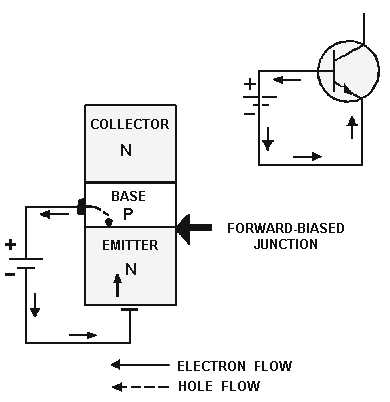2-8
Figure 2-5.—The forward-biased junction in an NPN transistor.
With the emitter-to-base junction in the figure biased in the forward direction, electrons leave the
negative terminal of the battery and enter the N material (emitter). Since electrons are majority current
carriers in the N material, they pass easily through the emitter, cross over the junction, and combine with
holes in the P material (base). For each electron that fills a hole in the P material, another electron will leave
the P material (creating a new hole) and enter the positive terminal of the battery.
NPN REVERSE-BIASED JUNCTION.—The second PN junction (base-to-collector), or reverse-
biased junction as it is called (fig. 2-6), blocks the majority current carriers from crossing the junction.
However, there is a very small current, mentioned earlier, that does pass through this junction. This current
is called minority current, or reverse current. As you recall, this current was produced by the electron-hole
pairs. The minority carriers for the reverse-biased PN junction are the electrons in the P material and the
holes in the N material. These minority carriers actually conduct the current for the reverse-biased junction
when electrons from the P material enter the N material, and the holes from the N material enter the P
material. However, the minority current electrons (as you will see later) play the most important part in the
operation of the NPN transistor.

